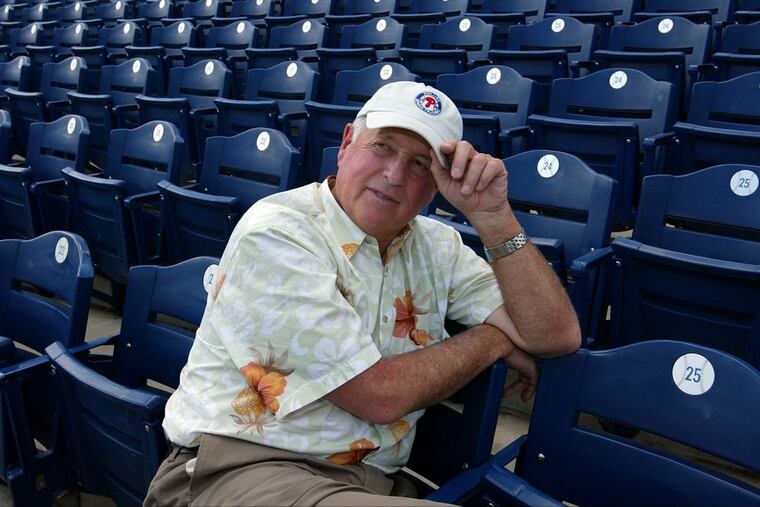Pat Gillick dampens expectations for 2018 Phillies | Marcus Hayes
The Phils' former GM likes Rhys Hoskins, Jake Arrieta & Co., but no amount of analytic evidence will convince him that they are on par with his 2008 World Series champions.

CLEARWATER, Fla. — One of the traits that earned Pat Gillick membership in the National Baseball Hall of Fame in 2011 and a spot on the Phillies Wall of Fame this year is his chronic truth-telling. For more than 30 years he told his managers, coaches, players, and owners exactly what he thought. Clear communication mattered then, and it matters now.
So, while it might hurt when Gillick says that the young core of this Phillies team isn't as gifted as his 2008 World Series winner, and that analytics aren't the Holy Grail, and that this Phillies team remains at least a year away from contention, he's just being honest.
"I thought '18 would be a year to compete," Gillick said at his Wall of Fame news conference Friday. "I think probably I was a little too optimistic."
His projections carry weight. He has been a front-office adviser since he retired as general manager in 2008, so he's close to the process. He's also a veteran of rebuildings: a three-time champion, twice with the Blue Jays, once with the Phillies. And he's always candid, even if he's not always right.
In 2015, he believed the Phils would be contenders this spring. Now, even with a bolstered bullpen and with Jake Arrieta added to the rotation, success will depend on youngsters such as outfielders Rhys Hoskins and Nick Williams and starters such as Aaron Nola.
"I think '18 will be an improvement over '17. But give Hoskins, give Williams, give these younger pitchers another year to get their feet on the ground," Gillick said. "I think '19 is a more realistic time to compete."
Maybe. Maybe not. At his trade-deadline fire sale in 2006, Gillick famously predicted that his Phillies wouldn't compete until 2009 despite its talented young core that featured Ryan Howard, Chase Utley, Jimmy Rollins, Pat Burrell, Shane Victorino, and Cole Hamels. That young core won the NL East the next season and the World Series the following year. This young group, he said, is not as good.
"The group of players I inherited were probably a little more talented than the group they have here," Gillick said. "Not to say this group isn't talented, but when you think back about 50 home runs, even though Ryan was a liability at first base; you think of a second baseman who hit 30 home runs and driving in over 100 runs; you think of guy at shortstop stealing 30 to 40 bases; the leftfielder hitting 25-30 home runs; the centerfielder probably one of the better centerfielders in baseball; and Cole Hamels ended up being the MVP of the World Series."
That said, Gillick believes that playoff veterans such as Arrieta, first baseman Carlos Santana, and relievers Tommy Hunter and Pat Neshek can speed the kids' education.
"The important thing is to learn how to win," he said. The Phillies averaged fewer than 70 wins the last five seasons.
Gillick's other gift is graciousness, on display again Friday. He thanked Ed Wade, his predecessor as general manager, for acquiring the young core that won in 2008. He thanked the late Paul Owens, who led the team to its first World Series win, in 1980, and who mentored Gillick when Gillick was a young GM. Gillick's first move: He purchased Tommy Hutton for $15,000 from Owens in 1977.
"It's a thrill to be on the Wall of Fame with 'The Pope,' " Gillick said. "In my estimation, he was one of the best general managers in the history of the game."
That's quite a compliment, coming from the fourth of five GMs in the Hall. All of those executives thrived before analytics began to dominate the game. Gillick values numbers, but he trusts his 80-year-old eyes, too.
"You have to maintain a balance between analytics and visual observation," Gillick said. "Visual observation and evaluation of players are very, very important. Scouts play a big role in knowing the player. What's in his heart. What's his passion. What's his instinct. Those are things that are very difficult to measure, analytically."
That said, Gillick would not have ignored the information and the indicators analytics deliver. Today, sabermatricians in front offices are reluctant to make investments that don't fit their model, which might mean fewer bad decisions like the ones his generation of GMs often made, he said. He figures the late signings of top free agents this year is rooted in analytic-based valuations, and he's fine with that. Gillick has been in baseball his whole life, but he understands that times change.
"We're now almost two decades into the 21st century. Time moves on," Gillick said. "New generation. New thought process. Just like technology. You can't stand and let it go by. You've got to get on the train."
As long as the train isn't on autopilot. "Certainly, I embrace analytics from that standpoint. I'm all in on analytics, as long as it's kept in balance with the visual observation and visual evaluation of a player," he said.
His visual evaluation of former Phillies ace Roy Halladay led the Blue Jays to draft Halladay in the first round in 1995. Gillick had resigned as Blue Jays GM after 1994 and become a consultant for the team, which asked him to watch a tournament in Mesa, Ariz., to see Halladay pitch for Arvada West (Colo.) High.
Halladay, who retired in 2013, died Nov. 7, when a plane he was piloting crashed into the Gulf of Mexico about 20 miles north of where Gillick spoke Friday at Spectrum Field. Halladay will join Gillick on the Phillies' Wall this year.
"It's unfortunate," Gillick said, "that he can't be up here with me today."